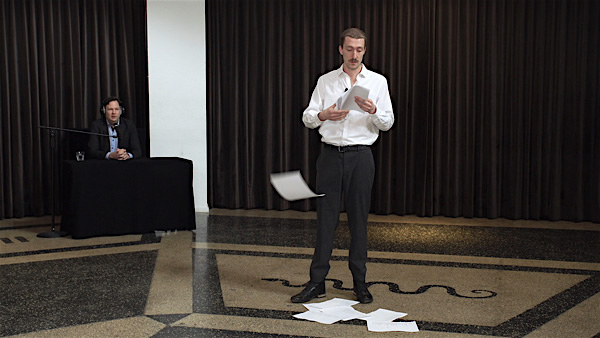SIMULTANEOUS CITY
2019
film installation
2019
film installation

Film installation
Ebensperger Rhomberg, Berlin, 2019
Installation views: ebensperger-rhomberg.net
Simultaneous City, short film, 27', HD, stereo
Based on the poem “Blonde City” written by Sándor Tar in 1969 in Dresden
Recitation: Philipp Droste
Simultaneous Translation: Ádám Kerpel-Fronius
Camera: István Imreh
Sound: Gregor Schweiger
Assistant: Árpád széll
Silent Green, Berlin, 2019
The piece Simultaneous City consists of a number of different elements in terms of format and genre, which are the following: a textbook, a film installation and a series of photographs. As in most of Nemeth's work, the point of departure is the written text, which is the basis of the filmed performance that employs speech.
The artist quotes and contextualises Sándor Tar’s poem Blonde City within the piece, and this case, performing the original poem, the recital and the means of transfer as a procedure is the subject of the experiment. The poem is read by an actor in original language, that is, Hungarian, and interpreted simultaneously by a professional German translator. The minimal alterations, thus, the versions that Nemeth normally creates by editing in her previous works, will therefore be randomly generated through the spontaneity of simultaneous translation.
The poem Blonde City is a 22-page typewritten piece from 1969, published recently in 2017 by the Déri Museum in the volume Sándor Tar – Prospectus.
Sándor Tar (1941-2005) is a Hungarian author of literary and sociographic works. “His literary work chronicles the fate of people confined to the periphery, who have been subdued by the lack of prospects and deep poverty.
Tar worked as a guest labourer in Dresden from 1967 until 1970, then as an instructor at a workers’ hostel in the same city in 1975-76. Drawing on his disheartening experiences of the conditions at the workers’ hostel, he wrote his sociographical essay “Prospectus” in Dresden. This was also when his poem “Blonde City” was conceived. In contrast with the objectivity of his sociographical writings, this poem is a piece written in personal tone, full of emotions, inspired by his love for Sabine, and his sympathy for the German woman's brother.
Planned simultaneously with, and related to, the above piece is the series of 25 photographs titled Sabine, Sabine, which forms a separate segment of the project. Similarly to mass-printed street posters, it iterates a single motif in a contiguous row. However, the repetition is illusory, as each poster is minimally different: they depict 25 phases of a single movement. The head turns from right to left, thus the first and last image in the series shows two opposite profiles, while the central images show the face in frontal view.
Some guidelines for interpretation of the work Simultaneous City:
- parallel processes of history, the scenes of societies and individual human destinies billowing along with these processes;
- ideas forced on the society by a regime out of political conviction;
- error in the system caused by spontaneity and incidence;
- the considerable difference between personal and objective language;
- universal language;
- universal phenomena, such as oppression;
- and what is cosmic in oppression: rising above it;
- the power springing from individual human dignity, the capacity for accommodation; understanding, love – under any circumstance.
Photo: Hajnal Németh, István Imreh